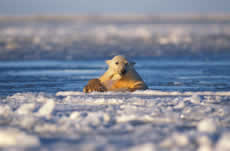Global Warming in the Arctic
A general pattern of change
The Earth's climate has been basically stable since the last ice age (about 10,000 years ago), allowing human life to prosper. Over the last two centuries, however, people have burned fossil fuels for energy at an ever-increasing rate – and the climate has begun to change. Burning fuel produces gases, such as carbon dioxide, which act like the windows of a greenhouse, trapping heat from the sun. As a result, the Earth is rapidly warming up.
What's happening in the Arctic
The Arctic is warming about twice as fast as most other places. The annual ice is disappearing earlier in the spring and refreezing later in the fall, and the permafrost under the tundra is melting. Open water and exposed vegetationboth darker than iceabsorb sun more readily than solid snowpack or sea ice. As Arctic summers lengthen, the warming process accelerates.
The warmer climate is drawing new species from southern ranges, introducing competition for already scant resources. The ice-dependent creatures in the Arctic that are adapted to life on the northern fringes of the world have nowhere to go. The Arctic web of life is becoming severely stressed.
Global Warming Disrupts This World
The ice is not the same as it used to be. The old ice that used to pile up and anchor out there is missing. It's disappearing. There is more water than ice now, and the land beneath it is eroding away. – Arnold Brower, Sr., Inupiaq elder
Evidence and impacts of change
The Arctic environment is clearly changing. Spring comes earlier; summer lasts longer. Some scientists predict that most of the Arctic Ocean could be free of ice within the next ten years.
The ice is retreating earlier – and moving farther away
Polar bears depend on sea ice as a hunting platform. They do best on the thin ice near the edge of the pack when it is relatively near shore. Here, in the nutrient-rich waters above the continental shelf, they find the greatest concentration of sealstheir main food source. As the Arctic warms, the ice recedes fartherand earlierfrom land and the continental shelf. Faced with a shortened and less productive spring hunting season, polar bears increasingly are entering the lean summer months without the fat stores they need to survive.
Loss of habitat threatens more than polar bears
Scientists predict that the world's polar bear population may decrease by about two-thirds by 2050. This would not occur in isolation; ecosystems around the world are interconnected. The loss of habitat that threatens the polar bears survival is also a threat to other ice-dependent Arctic species.
|

Polar bear emerges from sea (coastal plain, Arctic National Wildlife Refuge)
Photograph by Steven Kazlowski
|

